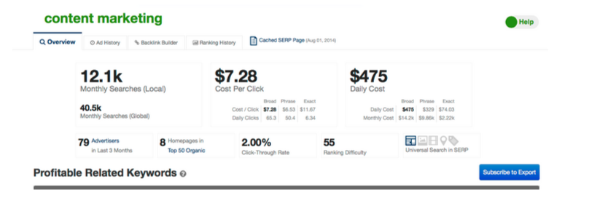This is a Guest Post from Neha Jewalikar from Radius.
VP of Marketing at iBASEt, Louis Columbus, argues that marketing is going through a transformation, which moves away from traditional tactics towards analytics and data-driven strategies that deliver measurable results. However, with the mass proliferation of data, marketers are often left overwhelmed. How can marketers make sense of data and apply it to their day-to-day processes?
Social Marketers
As social media constantly evolves, today’s marketers face a lofty challenge: proving the ROI of their campaigns. According to Adobe, 52% of marketers cite difficulties in accurately measuring ROI as their biggest source of frustration in social marketing. Rather than measuring the results of each campaign at the end, marketers should instead infuse each piece of content with data.
Here are some tools that can help marketers focus on what works and eliminate what doesn’t:
Twitter can be incredibly complex. How do you know when your followers are online, and if they are, how you do you maximize engagement? Social marketers often address this problem by sending out rapid-fire tweets at random times.
Tweriod is a free service that analyzes the performance of your past 200 tweets and then tells you when the best time to update is. For us at Radius, engagement peaks around noon. Use these insights to determine when the best time is to push out content and reach a majority of your audience.
Social Crawlytics allows you to identify your competitors’ most shared content. Once you run a report, it lets you to see how well your site is performing based on post statistics, top authors, and page level results. It also breaks down shares by content. You can then determine if your readers are more responsive to video, text, or images. Knowing which kind of content performs best will allow you to hone your marketing efforts and focus on top performing channels.
Twitter’s analytics dashboard provides insights on every tweet’s engagement, clicks, retweets, favorites, replies, and more. The platform also provides details on sponsored posts. It is available to all Twitter users who have an account that has been active for at least 14 days. By monitoring posts daily, you can look for patterns and create repeatable formulas for the tweets that perform well.
Content Marketers
Content Marketers often cite generating ideas as a major roadblock to creating content. In fact, only 32% of marketers say they are effectively executing enough content. How can content marketers use data to create content that solves the problems businesses face?
Marketers can leverage the following tools to ensure the content they are creating is worth their marketing dollars:
BuzzSumo fuels your content marketing and SEO campaigns with insights regarding which content works well in a specific industry or niche. It gives you a clear list of major influencers for each particular topic. The dashboard also breaks down shares by individual social networks. Use it to search for blog post ideas and determine which topics will perform the best.
Spyfu allows you to search for any domain, where it shows up on Google, every keyword the company has purchased on Adwords, every ad variation, and every organic rank in the last 6 years. It also enables you to monitor your paid and SEO rankings on search engines. Spyfu also includes keyword search, which provides details on monthly search, cost per click, and daily cost. Turn the insights you gather into meaningful discussions with your audience.
The Google Trends platform uses real-time search data to help you dive into consumer search behaviors. It measures how often specific search terms are entered into Google. You can compare up to 5 terms and sort data by time, language, demographics, and geographic location.
Will an article about SEO or SEM get more traction? Use the platform to find out which topic is worth devoting resources to.
As data-driven marketing becomes an ever-increasing trend, it’s important to dive deeper when presenting your results.
“It’s very easy for marketers to throw up an analytic smoke screen to executives” – Jerry Rackely.
While it’s great that your last campaign generated 20% more impressions than the prior one, it’s important to push these measurements further. Providing evidence for how those impressions will create leads and fill your funnel is necessary. Focus on metrics that add value to the bottom line and showcase data that can prove its value in dollars. At the end of the day, data can add immense value into a marketer’s daily routine. Invest in technologies that provide insights into what works and tweak what doesn’t.





